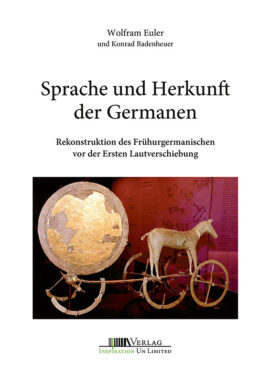Wolfram Euler and Konrad Badenheuer
Language and Origin of the Germanic Peoples – Reconstruction of Early Germanic before the First Sound Shift (November 2021)
2nd edition 2021
Hardcover, size 16.4 x 23.2 cm, 372 pages, in German
ISBN 978-3-945127-278
Resellers receive a discount, review copies are free of charge.
89,00 €
Experts were astonished when the Munich linguist Wolfram Euler presented the first complete account of this oldest Germanic language of the Bronze and Iron Ages in 2009 with his book “Sprache und Herkunft der Germanen” (Language and Origin of the Germanic Peoples): “This work, which breaks new ground, is based on profound knowledge of the linguistic material and the scientific literature. It is of fundamental importance for the further study of Germanic,” said the prominent ancient Germanist Alfred Bammesberger in praise of this book.
What did the language of the earliest Germanic peoples sound like in the Bronze and Iron Ages, i.e. in the first two millennia before Christ? At first glance, this question seems to be quite unanswerable, because no texts of any kind have survived from this period. The earliest runic inscriptions date from the 2nd century A.D., and from the time before that we know only single Germanic words from the works of ancient writers.
And yet it is possible to describe the language of the Germanic peoples in this early period quite accurately. This is made possible by meticulous comparison of the surviving ancient Germanic languages with each other and with the reconstructed proto-Indo-European language spoken in the 4th millennium BC.
Experts were astonished when the Munich linguist Wolfram Euler presented the first complete account of this oldest Germanic language of the Bronze and Iron Ages in 2009 with his book “Sprache und Herkunft der Germanen” (Language and Origin of the Germanic Peoples): “This work, which breaks new ground, is based on profound knowledge of the linguistic material and the scientific literature. It is of fundamental importance for the further study of Germanic,” said the prominent ancient Germanist Alfred Bammesberger in praise of this book.
When it appeared, the work filled a gap in research that had existed for about 120 years: For the first time, the transitional forms between Western Indo-European (c. 2000 BC) and Urgermanic (c. 100 BC) were researched and described in an overall account. Since then, numerous works have appeared, and the picture we have today of earliest Germanic has become increasingly precise. The new research and especially the further work of Wolfram Euler himself on this subject have made a new edition of the book, which has been out of print for years, necessary. There are additions and extensions in each part of the book.
In addition, human genetics research in recent years has dramatically increased our knowledge of prehistoric migration. The question of the origin of the Germanic tribes, which has been disputed for well over 100 years, can therefore be answered with increasing precision and certainty. Chapter I of this book, penned by Konrad Badenheuer, outlines the current state of research and describes some of the bizarre aberrations of science in dealing with the politically often abused subject of the Germanic tribes.

